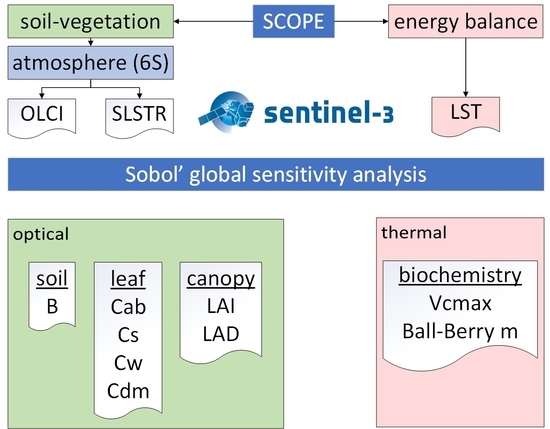Global Sensitivity Analysis of the SCOPE Model in Sentinel-3 Bands: Thermal Domain Focus
Abstract
:1. Introduction
2. Materials and Methods
2.1. SCOPE
2.1.1. Optical Radiative Transfer Module (RTMo)
2.1.2. Thermal Radiative Transfer Module (RTMt)
2.1.3. Energy Balance
2.2. Sentinel-3
2.3. Simulation of Sentinel-3 Signal
2.3.1. The Optical Domain (RTMo-6S)
The Atmosphere (6S)
2.3.2. The Thermal Domain (SCOPE)
2.4. Sobol’ Sensitivity Analysis
2.4.1. Implementation in SALib
2.4.2. Parameter Boundaries
2.5. Retrieval on Synthetic Dataset
3. Results
3.1. RTMo-6S GSA 400–2400 nm
3.1.1. OLCI
3.1.2. SLSTR
3.2. TOA Retrieval (Synthetic Data)
3.3. SCOPE GSA 2.5–50 um
LST
4. Discussion
4.1. RTMo-6S GSA 400–2400 nm
4.2. OLCI and SLSTR Bands
4.3. TOA Retrieval (Synthetic Data)
4.4. SCOPE GSA 2.5–50 um
4.5. Limitations
5. Conclusions
Author Contributions
Funding
Acknowledgments
Conflicts of Interest
Software
| SCOPE v.1.73 | https://github.com/Christiaanvandertol/SCOPE docs: https://scope-model.rtfd.io |
| RTMo retrieval algorithm | https://github.com/Prikaziuk/retrieval_rtmo docs: https://scope-model.rtfd.io/en/latest/retrieval.html |
| Py6S | https://github.com/robintw/Py6S docs: https://py6s.readthedocs.io |
| SALib | https://github.com/SALib/SALib docs: https://salib.rtfd.io |
| gp_emulator | https://github.com/jgomezdans/gp_emulator docs: https://gp-emulator.rtfd.io |
Appendix A. Results
Appendix LST Difference in Viewing Angles

Appendix B. Materials and Methods
Appendix B.1. Atmospheric Correction in 6S Atmospheric Model
Appendix B.2. Output Parameters of 6S Atmospheric Model
| Symbol | 6S Output Name | Parameter |
|---|---|---|
| direct solar irr. | bottom of atmosphere direct solar irradiance | |
| atm. diffuse irr. | bottom of atmosphere diffuse solar irradiance | |
| atm. intrin. rad. | atmospheric path radiance (at top of atmosphere) | |
| top of atmosphere solar radiance | ||
| global gas. trans. total | total gaseous transmittance | |
| total sca. trans. total | total scattering (aerosol) transmittance | |
| S | spherical albedo total | spherical albedo of the atmosphere |
Appendix B.3. Sobol’ Parameter Sampling in SALib
Appendix B.4. Sobol’ Integration in SALib
Appendix C. Fixed Model Parameters
Appendix C.1. 6S Fixed Parameters
| Parameter | Definition | Unit | Value |
|---|---|---|---|
| Geometrical conditions | |||
| sza | solar zenith angle | deg | 50 |
| saa | solar azimuth angle | deg | 150 |
| oza | observation zenith angle | deg | 22 (50) |
| oaa | observation azimuth angle | deg | 100 (195) |
| day | day | - | 14 |
| month | month | - | 7 |
| Atmospheric conditions | |||
| - | atmospheric profile | - | US62 |
| Aerosol type | |||
| - | aerosol model | - | Continental |
| Altitudes | |||
| - | sensor altitude | km | 1000 (on board of satellite) |
| - | target altitude | km | 0.25 |
| Ground reflectance | |||
| - | homogeneous Lambertian | - | Green vegetation |
Appendix C.2. SCOPE Fixed Parameters
| Parameter | Definition | Unit | Value |
|---|---|---|---|
| Leaf thermal | |||
| rho_thermal | broadband leaf reflectance in thermal range | - | 0.01 |
| tau_thermal | broadband leaf transmittance in thermal range | - | 0.01 |
| Leaf biochemical | |||
| BallBerry0 | - | 0.01 | |
| Type | photochemical pathway (C3 or C4) | - | C3 |
| Fluorescence | |||
| Tparam | temperature response of fluorescence | K | [0.2, 0.3, 281, 308, 328] |
| fqe | fluorescence quantum yield efficiency at photosystem level | - | 0.01 |
| Soil | |||
| rs_thermal | broadband soil reflectance in the thermal range | - | 0.06 |
| cs | specific heat capacity of the soil | J kg K | 1180 |
| rhos | specific mass of the soil | kg m | 1800 |
| Meteo | |||
| Oa | atmospheric O concentration | per mille | 209 |
| Aerodynamic | |||
| CR | drag coefficient for isolated tree | - | 0.35 |
| CD1 | fitting parameter | - | 20.6 |
| Psicor | roughness layer correction | - | 0.2 |
| CSSOIL | drag coefficient for soil | - | 0.01 |
| rb | leaf boundary resistance | s m | 10 |
| Angles | |||
| tts | solar zenith angle | deg | 50 |
| tto | observations zenith angle | deg | 22 (50) |
| psi | relative azimuth angle | deg | 130 (135) |
References
- Zamora-Sillero, E.; Hafner, M.; Ibig, A.; Stelling, J.; Wagner, A. Efficient characterization of high-dimensional parameter spaces for systems biology. BMC Syst. Biol. 2011, 5. [Google Scholar] [CrossRef] [PubMed]
- Saltelli, A.; Annoni, P.; Azzini, I.; Campolongo, F.; Ratto, M.; Tarantola, S. Variance based sensitivity analysis of model output. Design and estimator for the total sensitivity index. Comput. Phys. Commun. 2010, 181, 259–270. [Google Scholar] [CrossRef]
- Jacquemoud, S.; Baret, F. PROSPECT: A model of leaf optical properties spectra. Remote Sens. Environ. 1990, 34, 75–91. [Google Scholar] [CrossRef]
- Li, P.; Wang, Q. Retrieval of Leaf Biochemical Parameters Using PROSPECT Inversion: A New Approach for Alleviating Ill-Posed Problems. IEEE Trans. Geosci. Remote Sens. 2011, 49, 2499–2506. [Google Scholar] [CrossRef]
- Sun, J.; Shi, S.; Yang, J.; Gong, W.; Qiu, F.; Wang, L.; Du, L.; Chen, B. Wavelength selection of the multispectral lidar system for estimating leaf chlorophyll and water contents through the PROSPECT model. Agric. For. Meteorol. 2019, 266-267, 43–52. [Google Scholar] [CrossRef]
- Sun, W.X.; Liang, S. Advances in Land Remote Sensing; Springer: Dordrecht, The Netherlands, 2008; pp. 369–393. [Google Scholar] [CrossRef]
- Jay, S.; Bendoula, R.; Hadoux, X.; Féret, J.B.B.; Gorretta, N. A physically-based model for retrieving foliar biochemistry and leaf orientation using close-range imaging spectroscopy. Remote Sens. Environ. 2016, 177, 220–236. [Google Scholar] [CrossRef] [Green Version]
- Wang, Z.; Skidmore, A.K.; Wang, T.; Darvishzadeh, R.; Hearne, J. Applicability of the PROSPECT model for estimating protein and cellulose + lignin in fresh leaves. Remote Sens. Environ. 2015, 168, 205–218. [Google Scholar] [CrossRef]
- Stuckens, J.; Verstraeten, W.W.; Delalieux, S.; Swennen, R.; Coppin, P. A dorsiventral leaf radiative transfer model: Development, validation and improved model inversion techniques. Remote Sens. Environ. 2009, 113, 2560–2573. [Google Scholar] [CrossRef]
- Verhoef, W. Light scattering by leaf layers with application to canopy reflectance modeling: The SAIL model. Remote Sens. Environ. 1984, 16, 125–141. [Google Scholar] [CrossRef] [Green Version]
- Schlerf, M.; Atzberger, C. Inversion of a forest reflectance model to estimate structural canopy variables from hyperspectral remote sensing data. Remote Sens. Environ. 2006, 100, 281–294. [Google Scholar] [CrossRef]
- Zhu, X.X.; Skidmore, A.K.; Darvishzadeh, R.; Wang, T. Estimation of forest leaf water content through inversion of a radiative transfer model from LiDAR and hyperspectral data. Int. J. Appl. Earth Obs. Geoinf. 2019, 74, 120–129. [Google Scholar] [CrossRef]
- Wang, Z.; Skidmore, A.K.; Darvishzadeh, R.; Wang, T. Mapping forest canopy nitrogen content by inversion of coupled leaf-canopy radiative transfer models from airborne hyperspectral imagery. Agric. For. Meteorol. 2018, 253–254, 247–260. [Google Scholar] [CrossRef]
- Tagliabue, G.; Panigada, C.; Dechant, B.; Baret, F.; Cogliati, S.; Colombo, R.; Migliavacca, M.; Rademske, P.; Schickling, A.; Schüttemeyer, D.; et al. Exploring the spatial relationship between airborne-derived red and far-red sun-induced fluorescence and process-based GPP estimates in a forest ecosystem. Remote Sens. Environ. 2019, 231, 111272. [Google Scholar] [CrossRef]
- Bowyer, P.; Danson, F.M. Sensitivity of spectral reflectance to variation in live fuel moisture content at leaf and canopy level. Remote Sens. Environ. 2004, 92, 297–308. [Google Scholar] [CrossRef]
- Xiao, Y.; Zhao, W.; Zhou, D.; Gong, H. Sensitivity Analysis of Vegetation Reflectance to Biochemical and Biophysical Variables at Leaf, Canopy, and Regional Scales. IEEE Trans. Geosci. Remote Sens. 2014, 52, 4014–4024. [Google Scholar] [CrossRef]
- Bacour, C. Design and analysis of numerical experiments to compare four canopy reflectance models. Remote Sens. Environ. 2002, 79, 72–83. [Google Scholar] [CrossRef]
- Morris, R.D.; Kottas, A.; Taddy, M.; Furfaro, R.; Ganapol, B.D. A Statistical Framework for the Sensitivity Analysis of Radiative Transfer Models. IEEE Trans. Geosci. Remote Sens. 2008, 46, 4062–4074. [Google Scholar] [CrossRef]
- Gu, C.; Du, H.; Mao, F.; Han, N.; Zhou, G.; Xu, X.; Sun, S.; Gao, G. Global sensitivity analysis of PROSAIL model parameters when simulating Moso bamboo forest canopy reflectance. Int. J. Remote Sens. 2016, 37, 5270–5286. [Google Scholar] [CrossRef]
- Pfeifer, M.; Korhonen, L.; Wheeler, C.; Rautiainen, M. Forest canopy structure and reflectance in humid tropical Borneo: A physically-based interpretation using spectral invariants. Remote Sens. Environ. 2017, 201, 314–330. [Google Scholar] [CrossRef] [Green Version]
- Zhang, C.; Pattey, E.; Liu, J.; Cai, H.; Shang, J.; Dong, T. Retrieving Leaf and Canopy Water Content of Winter Wheat Using Vegetation Water Indices. IEEE J. Sel. Top. Appl. Earth Obs. Remote Sens. 2018, 11, 112–126. [Google Scholar] [CrossRef]
- Dong, T.; Liu, J.; Shang, J.; Qian, B.; Ma, B.; Kovacs, J.M.; Walters, D.; Jiao, X.; Geng, X.; Shi, Y. Assessment of red-edge vegetation indices for crop leaf area index estimation. Remote Sens. Environ. 2019, 222, 133–143. [Google Scholar] [CrossRef]
- Xu, J.; Meng, J.; Quackenbush, L.J. Use of remote sensing to predict the optimal harvest date of corn. Field Crops Res. 2019, 236, 1–13. [Google Scholar] [CrossRef]
- Berk, A.; Conforti, P.; Kennett, R.; Perkins, T.; Hawes, F.; van den Bosch, J. MODTRAN6: A major upgrade of the MODTRAN radiative transfer code. In Proceedings of the 2014 6th Workshop on Hyperspectral Image and Signal Processing: Evolution in Remote Sensing (WHISPERS), Lausanne, Switzerland, 24–27 June 2014; p. 90880H. [Google Scholar] [CrossRef]
- Anderson, G.P.; Berk, A.; Acharya, P.K. Reformulated Atmospheric Band Model Method for Modeling Atmospheric Propagation at Arbitrarily Fine Spectral Resolution and Expanded Capabilities. U.S. Patent 7,593,835, 22 September 2009. [Google Scholar]
- Mousivand, A.; Menenti, M.; Gorte, B.; Verhoef, W. Global sensitivity analysis of the spectral radiance of a soil-vegetation system. Remote Sens. Environ. 2014, 145, 131–144. [Google Scholar] [CrossRef]
- Mousivand, A.; Menenti, M.; Gorte, B.; Verhoef, W. Multi-temporal, multi-sensor retrieval of terrestrial vegetation properties from spectral-directional radiometric data. Remote Sens. Environ. 2015, 158, 311–330. [Google Scholar] [CrossRef]
- Vermote, E.F.; Tanre, D.; Deuze, J.L.; Herman, M.; Morcette, J.J. Second Simulation of the Satellite Signal in the Solar Spectrum, 6S: An overview. IEEE Trans. Geosci. Remote Sens. 1997, 35, 675–686. [Google Scholar] [CrossRef]
- Ceccato, P.; Flasse, S.; Grégoire, J.M. Designing a spectral index to estimate vegetation water content from remote sensing data: Part 1: Theoretical approach. Remote Sens. Environ. 2002, 82, 188–197. [Google Scholar] [CrossRef]
- Shi, H.; Xiao, Z.; Liang, S.; Zhang, X. Consistent estimation of multiple parameters from MODIS top of atmosphere reflectance data using a coupled soil-canopy-atmosphere radiative transfer model. Remote Sens. Environ. 2016, 184, 40–57. [Google Scholar] [CrossRef]
- Liu, J.; Pattey, E.; Jégo, G. Assessment of vegetation indices for regional crop green LAI estimation from Landsat images over multiple growing seasons. Remote Sens. Environ. 2012, 123, 347–358. [Google Scholar] [CrossRef]
- Verrelst, J.; Vicent, J.; Rivera-Caicedo, J.P.; Lumbierres, M.; Morcillo-Pallarés, P.; Moreno, J. Global Sensitivity Analysis of Leaf-Canopy-Atmosphere RTMs: Implications for Biophysical Variables Retrieval from Top-of-Atmosphere Radiance Data. Remote Sens. 2019, 11, 1923. [Google Scholar] [CrossRef]
- Verrelst, J.; Rivera, J.P.; van der Tol, C.; Magnani, F.; Mohammed, G.; Moreno, J. Global sensitivity analysis of the SCOPE model: What drives simulated canopy-leaving sun-induced fluorescence? Remote Sens. Environ. 2015, 166, 8–21. [Google Scholar] [CrossRef]
- Wolanin, A.; Camps-Valls, G.; Gómez-Chova, L.; Mateo-García, G.; van der Tol, C.; Zhang, Y.; Guanter, L. Estimating crop primary productivity with Sentinel-2 and Landsat 8 using machine learning methods trained with radiative transfer simulations. Remote Sens. Environ. 2019, 225, 441–457. [Google Scholar] [CrossRef]
- Jin, J.; Wang, Q.; Wang, J.; Otieno, D. Tracing water and energy fluxes and reflectance in an arid ecosystem using the integrated model SCOPE. J. Environ. Manag. 2019, 231, 1082–1090. [Google Scholar] [CrossRef] [PubMed]
- Bayat, B.; van der Tol, C.; Verhoef, W. Integrating satellite optical and thermal infrared observations for improving daily ecosystem functioning estimations during a drought episode. Remote Sens. Environ. 2018, 209, 375–394. [Google Scholar] [CrossRef]
- Krinner, G.; Viovy, N.; de Noblet-Ducoudré, N.; Ogée, J.; Polcher, J.; Friedlingstein, P.; Ciais, P.; Sitch, S.; Prentice, I.C. A dynamic global vegetation model for studies of the coupled atmosphere-biosphere system. Glob. Biogeochem. Cycles 2005, 19, 1–33. [Google Scholar] [CrossRef]
- Niu, G.Y.; Yang, Z.L.; Mitchell, K.E.; Chen, F.; Ek, M.B.; Barlage, M.; Kumar, A.; Manning, K.; Niyogi, D.; Rosero, E.; et al. The community Noah land surface model with multiparameterization options (Noah-MP): 1. Model description and evaluation with local-scale measurements. J. Geophys. Res. 2011, 116, D12109. [Google Scholar] [CrossRef] [Green Version]
- Jaber, F.H.; Shukla, S. MIKE SHE: Model Use, Calibration, and Validation. Trans. ASABE 2012, 55, 1479–1489. [Google Scholar] [CrossRef]
- Petropoulos, G.; Carlson, T.; Wooster, M. An Overview of the Use of the SimSphere Soil Vegetation Atmosphere Transfer (SVAT) Model for the Study of Land-Atmosphere Interactions. Sensors 2009, 9, 4286–4308. [Google Scholar] [CrossRef] [Green Version]
- Van der Tol, C.; Verhoef, W.; Timmermans, J.; Verhoef, A.; Su, Z. An integrated model of soil-canopy spectral radiances, photosynthesis, fluorescence, temperature and energy balance. Biogeosciences 2009, 6, 3109–3129. [Google Scholar] [CrossRef] [Green Version]
- Duffour, C.; Olioso, A.; Demarty, J.; van der Tol, C.; Lagouarde, J.P.; Tol, C.V.D.; Lagouarde, J.P. An evaluation of SCOPE: A tool to simulate the directional anisotropy of satellite-measured surface temperatures. Remote Sens. Environ. 2015, 158, 362–375. [Google Scholar] [CrossRef]
- van der Tol, C.; Vilfan, N.; Dauwe, D.; Cendrero-Mateo, M.P.; Yang, P. The scattering and re-absorption of red and near-infrared chlorophyll fluorescence in the models Fluspect and SCOPE. Remote Sens. Environ. 2019, 232, 111292. [Google Scholar] [CrossRef]
- Vilfan, N.; van der Tol, C.; Muller, O.; Rascher, U.; Verhoef, W. Fluspect-B: A model for leaf fluorescence, reflectance and transmittance spectra. Remote Sens. Environ. 2016, 186, 596–615. [Google Scholar] [CrossRef]
- Verhoef, W.; van der Tol, C.; Middleton, E.M. Hyperspectral radiative transfer modeling to explore the combined retrieval of biophysical parameters and canopy fluorescence from FLEX—Sentinel-3 tandem mission multi-sensor data. Remote Sens. Environ. 2018, 204, 942–963. [Google Scholar] [CrossRef]
- Jiang, C.; Fang, H. GSV: A general model for hyperspectral soil reflectance simulation. Int. J. Appl. Earth Obs. Geoinf. 2019, 83, 101932. [Google Scholar] [CrossRef]
- Collatz, G.; Ball, J.; Grivet, C.; Berry, J.A. Physiological and environmental regulation of stomatal conductance, photosynthesis and transpiration: A model that includes a laminar boundary layer. Agric. For. Meteorol. 1991, 54, 107–136. [Google Scholar] [CrossRef]
- Collatz, G.J.; Ribas-Carbo, M.; Berry, J.J.A. Coupled photosynthesis-stomatal conductance model for leaves of C4 plants. Aust. J. Plant Physiol. 1992, 19, 519. [Google Scholar] [CrossRef]
- Van der Tol, C.; Berry, J.A.; Campbell, P.K.E.; Rascher, U. Models of fluorescence and photosynthesis for interpreting measurements of solar-induced chlorophyll fluorescence. J. Geophys. Res. Biogeosci. 2014, 119, 2312–2327. [Google Scholar]
- Verhoef, W. Earth observation modeling based on layer scattering matrices. Remote Sens. Environ. 1985, 17, 165–178. [Google Scholar] [CrossRef] [Green Version]
- Verhoef, W. Theory of Radiative Transfer Models Applied in Optical Remote Sensing of Vegetation Canopies; Wageningen University & Research: Wageningen, The Netherlands, 1998; p. 310. [Google Scholar]
- Schaepman-Strub, G.; Schaepman, M.E.; Painter, T.H.; Dangel, S.; Martonchik, J.V. Reflectance quantities in optical remote sensing-definitions and case studies. Remote Sens. Environ. 2006, 103, 27–42. [Google Scholar] [CrossRef]
- Paulson, C.A. The Mathematical Representation of Wind Speed and Temperature Profiles in the Unstable Atmospheric Surface Layer. J. Appl. Meteorol. 1970, 9, 857–861. [Google Scholar] [CrossRef]
- Verhoef, A.; Wallace, J. Modelling interactions in mixed-plant communities: Light, water and carbon dioxide. Leaf Dev. Canopy Growth 2000, 204, 250. [Google Scholar]
- Gómez-Dans, J.; Lewis, P.; Disney, M. Efficient Emulation of Radiative Transfer Codes Using Gaussian Processes and Application to Land Surface Parameter Inferences. Remote Sens. 2016, 8, 119. [Google Scholar] [CrossRef]
- Gómez-Dans, J.; Lewis, P.P. jgomezdans/gp_emulator: Added Inverse Emulators. 2018. Available online: https://zenodo.org/record/1460970#.XaV7SNK-uUk (accessed on 18 October 2019).
- Donlon, C.; Berruti, B.; Buongiorno, A.; Ferreira, M.; Féménias, P.; Frerick, J.; Goryl, P.; Klein, U.; Laur, H.; Mavrocordatos, C.; et al. Remote Sensing of Environment The Global Monitoring for Environment and Security (GMES) Sentinel-3 mission. Remote Sens. Environ. 2012, 120, 37–57. [Google Scholar] [CrossRef]
- Drusch, M.; Moreno, J.; Bello, U.D.; Franco, R.; Goulas, Y.; Huth, A.; Kraft, S.; Middleton, E.M.; Miglietta, F.; Mohammed, G.; et al. The FLuorescence EXplorer Mission Concept—ESA’s Earth Explorer 8. IEEE Trans. Geosci. Remote Sens. 2017, 55, 1273–1284. [Google Scholar] [CrossRef]
- Wilson, R.T. Py6S: A Python interface to the 6S radiative transfer model. Comput. Geosci. 2013, 51, 166–171. [Google Scholar] [CrossRef]
- Philippe Goryl, E.; Buongiorno, A.; Santella EUMETSAT Vincent Fournier-Sicre, C.; Santacesaria, V. NILU SENTINEL-3 Optical Products and Algorithm Definition Slstr Atbd Land Surface Temperature; Technical Report; University of Leicester: Leicester, UK, 2012. [Google Scholar]
- Zheng, Y.; Ren, H.; Guo, J.; Ghent, D.; Tansey, K.; Hu, X.; Nie, J.; Chen, S. Land Surface Temperature Retrieval from Sentinel-3A Sea and Land Surface Temperature Radiometer, Using a Split-Window Algorithm. Remote Sens. 2019, 11, 650. [Google Scholar] [CrossRef]
- Herman, J.; Usher, W. SALib: An open-source Python library for Sensitivity Analysis. J. Open Source Softw. 2017, 2. [Google Scholar] [CrossRef]
- Sobol, I.M. Sensitivity analysis for nonlinear mathematical models. Math. Model. Comput. 1993, 1, 407–414. [Google Scholar] [CrossRef]
- Nossent, J.; Elsen, P.; Bauwens, W. Sobol’ sensitivity analysis of a complex environmental model. Environ. Model. Softw. 2011, 26, 1515–1525. [Google Scholar] [CrossRef]
- Sobol’, I.M. On the distribution of points in a cube and the approximate evaluation of integrals. USSR Comput. Math. Math. Phys. 1967, 7, 86–112. [Google Scholar] [CrossRef]
- Sobol, I.M. Uniformly distributed sequences with an additional uniform property. USSR Comput. Math. Math. Phys. 1976, 16, 236–242. [Google Scholar] [CrossRef]
- Zhang, X.Y.; Trame, M.N.; Lesko, L.J.; Schmidt, S. Sobol sensitivity analysis: A tool to guide the development and evaluation of systems pharmacology models. CPT Pharmacomet. Syst. Pharmacol. 2015, 4, 69–79. [Google Scholar] [CrossRef] [PubMed]
- van der Tol, C.; Rossini, M.; Cogliati, S.; Verhoef, W.; Colombo, R.; Rascher, U.; Mohammed, G. A model and measurement comparison of diurnal cycles of sun-induced chlorophyll fluorescence of crops. Remote Sens. Environ. 2016, 186, 663–677. [Google Scholar] [CrossRef]
- Coleman, T.F.; Li, Y. On the convergence of interior-reflective Newton methods for nonlinear minimization subject to bounds. Math. Program. 1994, 67, 189–224. [Google Scholar] [CrossRef]
- Coleman, T.F.; Li, Y. An Interior Trust Region Approach for Nonlinear Minimization Subject to Bounds. SIAM J. Optim. 1996, 6, 418–445. [Google Scholar] [CrossRef] [Green Version]
- Proctor, C.; Lu, B.; He, Y. Determining the absorption coefficients of decay pigments in decomposing monocots. Remote Sens. Environ. 2017, 199, 137–153. [Google Scholar] [CrossRef]
- Verrelst, J.; van der Tol, C.; Magnani, F.; Sabater, N.; Rivera, J.P.; Mohammed, G.; Moreno, J. Evaluating the predictive power of sun-induced chlorophyll fluorescence to estimate net photosynthesis of vegetation canopies: A SCOPE modeling study. Remote Sens. Environ. 2016, 176, 139–151. [Google Scholar] [CrossRef]
- Verrelst, J.; Rivera, J.P.; Gitelson, A.; Delegido, J.; Moreno, J.; Camps-Valls, G. Spectral band selection for vegetation properties retrieval using Gaussian processes regression. Int. J. Appl. Earth Obs. Geoinf. 2016, 52, 554–567. [Google Scholar] [CrossRef]
- Féret, J.B.; Gitelson, A.A.; Noble, S.D.; Jacquemoud, S. PROSPECT-D: Towards modeling leaf optical properties through a complete lifecycle. Remote Sens. Environ. 2017, 193, 204–215. [Google Scholar] [CrossRef] [Green Version]
- Brown, L.A.; Dash, J.; Lidon, A.L.; Lopez-Baeza, E.; Dransfeld, S. Synergetic Exploitation of the Sentinel-2 Missions for Validating the Sentinel-3 Ocean and Land Color Instrument Terrestrial Chlorophyll Index Over a Vineyard Dominated Mediterranean Environment. IEEE J. Sel. Top. Appl. Earth Obs. Remote Sens. 2019, 12, 2244–2251. [Google Scholar] [CrossRef]
- Guzinski, R.; Nieto, H. Evaluating the feasibility of using Sentinel-2 and Sentinel-3 satellites for high-resolution evapotranspiration estimations. Remote Sens. Environ. 2019, 221, 157–172. [Google Scholar] [CrossRef]
- Martonchik, J.V.; Diner, D.J.; Crean, K.A.; Bull, M.A. Regional aerosol retrieval results from MISR. IEEE Trans. Geosci. Remote Sens. 2002, 40, 1520–1531. [Google Scholar] [CrossRef]
- Liang, S.; Li, X.; Wang, J. Advanced Remote Sensing: Terrestrial Information Extraction and Applications; Academic Press: Cambridge, MA, USA, 2012. [Google Scholar]
- le Maire, G.; Marsden, C.; Verhoef, W.; Ponzoni, F.J.; Lo Seen, D.; Bégué, A.; Stape, J.L.; Nouvellon, Y. Leaf area index estimation with MODIS reflectance time series and model inversion during full rotations of Eucalyptus plantations. Remote Sens. Environ. 2011, 115, 586–599. [Google Scholar] [CrossRef]
- Ridler, M.E.; Sandholt, I.; Butts, M.; Lerer, S.; Mougin, E.; Timouk, F.; Kergoat, L.; Madsen, H. Calibrating a soil-vegetation-atmosphere transfer model with remote sensing estimates of surface temperature and soil surface moisture in a semi arid environment. J. Hydrol. 2012, 436–437, 1–12. [Google Scholar] [CrossRef]
- Dantec-Nédélec, S.; Ottlé, C.; Wang, T.; Guglielmo, F.; Maignan, F.; Delbart, N.; Valdayskikh, V.; Radchenko, T.; Nekrasova, O.; Zakharov, V.; et al. Testing the capability of ORCHIDEE land surface model to simulate Arctic ecosystems: Sensitivity analysis and site-level model calibration. J. Adv. Model. Earth Syst. 2017, 9, 1212–1230. [Google Scholar] [CrossRef]
- Li, J.; Chen, F.; Zhang, G.; Barlage, M.; Gan, Y.; Xin, Y.; Wang, C. Impacts of Land Cover and Soil Texture Uncertainty on Land Model Simulations Over the Central Tibetan Plateau. J. Adv. Model. Earth Syst. 2018, 10, 2121–2146. [Google Scholar] [CrossRef] [Green Version]
- Petropoulos, G.; Ireland, G.; Griffiths, H.; Kennedy, M.; Ioannou-Katidis, P.; Kalivas, D. Extending the Global Sensitivity Analysis of the SimSphere model in the Context of its Future Exploitation by the Scientific Community. Water 2015, 7, 2101–2141. [Google Scholar] [CrossRef] [Green Version]
- Vicent, J.; Sabater, N.; Tenjo, C.; Acarreta, J.R.; Manzano, M.; Rivera, J.P.; Jurado, P.; Franco, R.; Alonso, L.; Verrelst, J.; et al. FLEX end-to-end mission performance simulator. IEEE Trans. Geosci. Remote Sens. 2016, 54, 4215–4223. [Google Scholar] [CrossRef]
- Sánchez, J.M.; Kustas, W.P.; Caselles, V.; Anderson, M.C. Modelling surface energy fluxes over maize using a two-source patch model and radiometric soil and canopy temperature observations. Remote Sens. Environ. 2008, 112, 1130–1143. [Google Scholar] [CrossRef]
- Peres, L.F.; DaCamara, C.C. Land surface temperature and emissivity estimation based on the two-temperature method: Sensitivity analysis using simulated MSG/SEVIRI data. Remote Sens. Environ. 2004, 91, 377–389. [Google Scholar] [CrossRef]
- Saltelli, A. Making best use of model evaluations to compute sensitivity indices. Comput. Phys. Commun. 2002, 145, 280–297. [Google Scholar] [CrossRef]
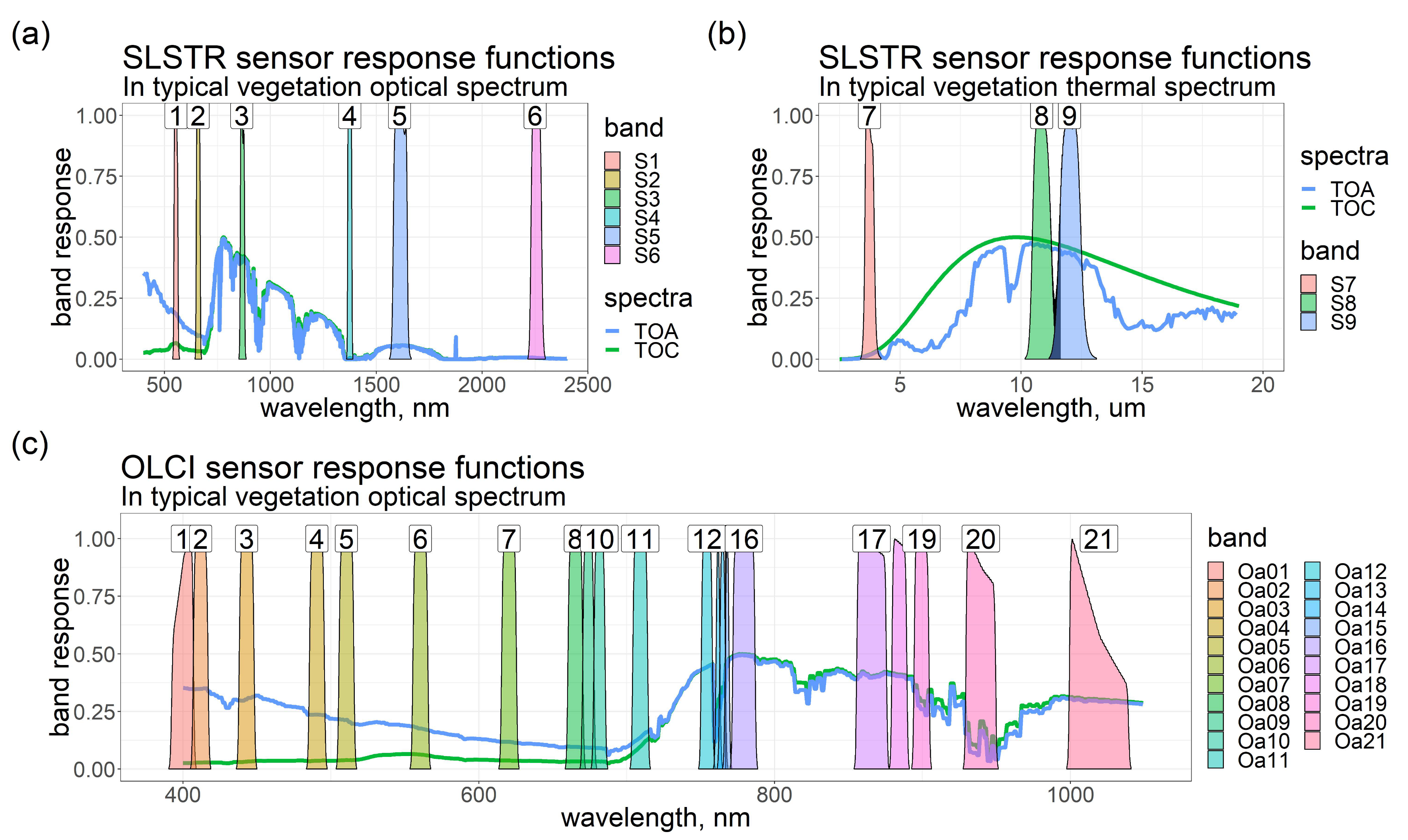
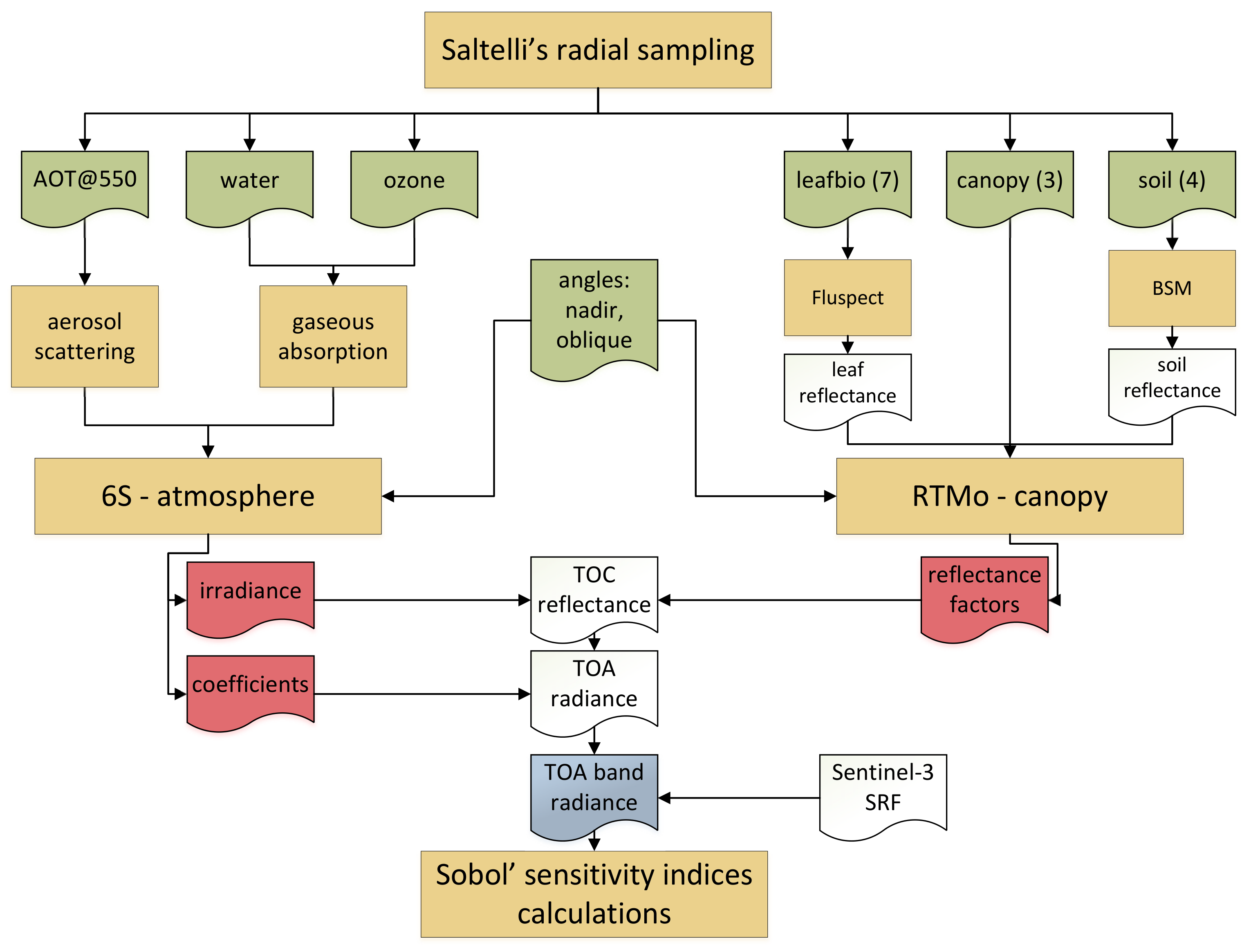
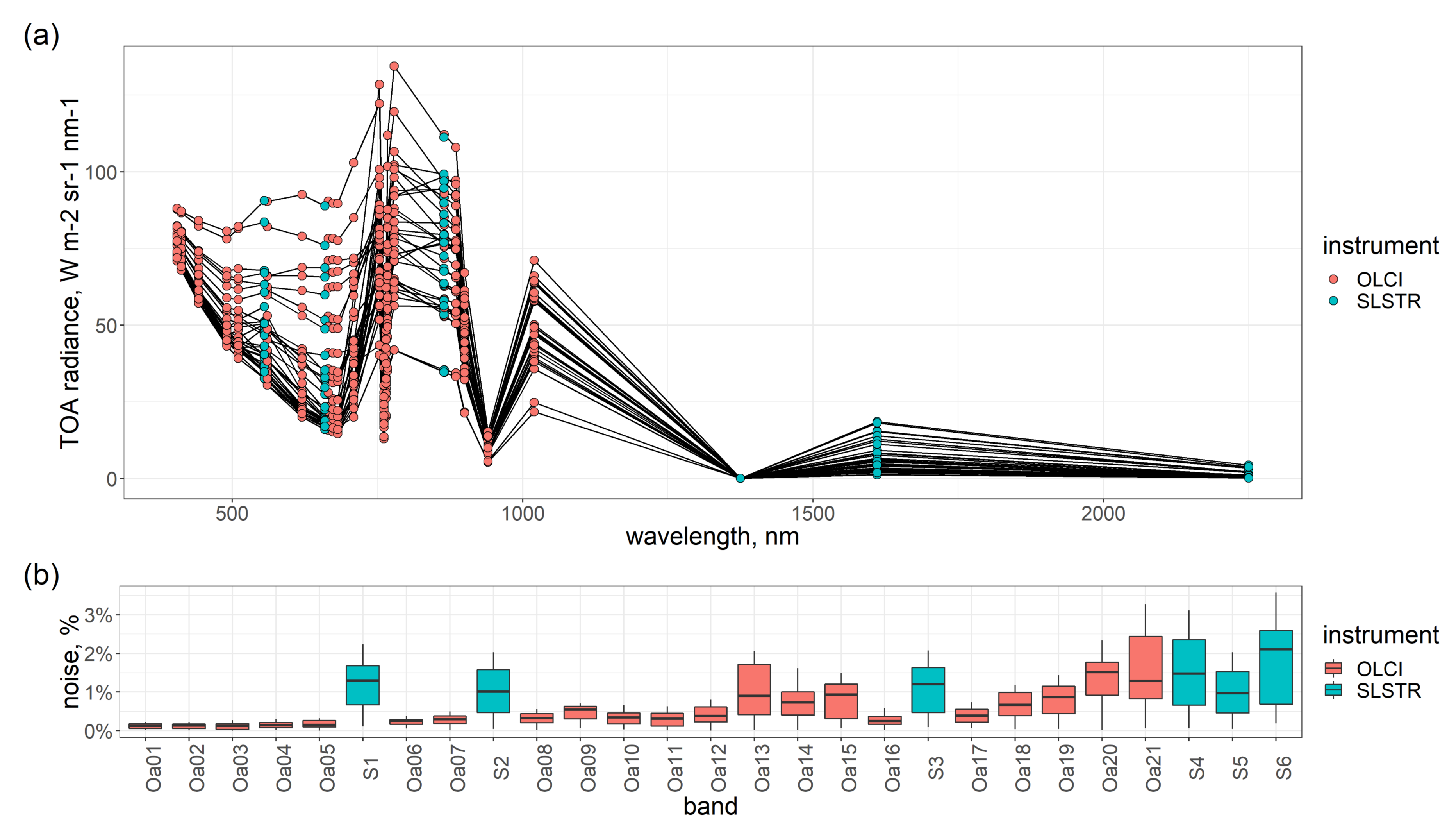
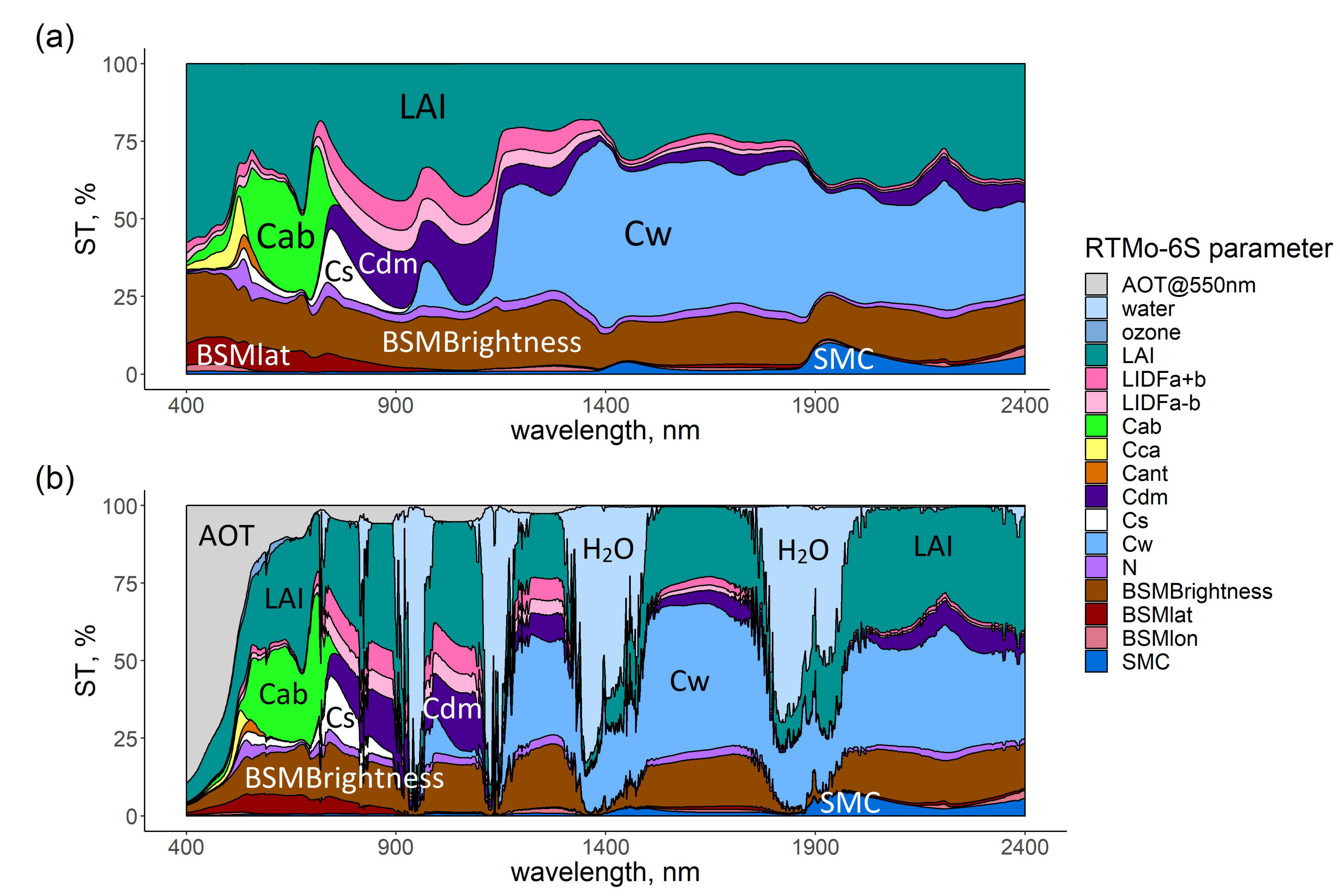
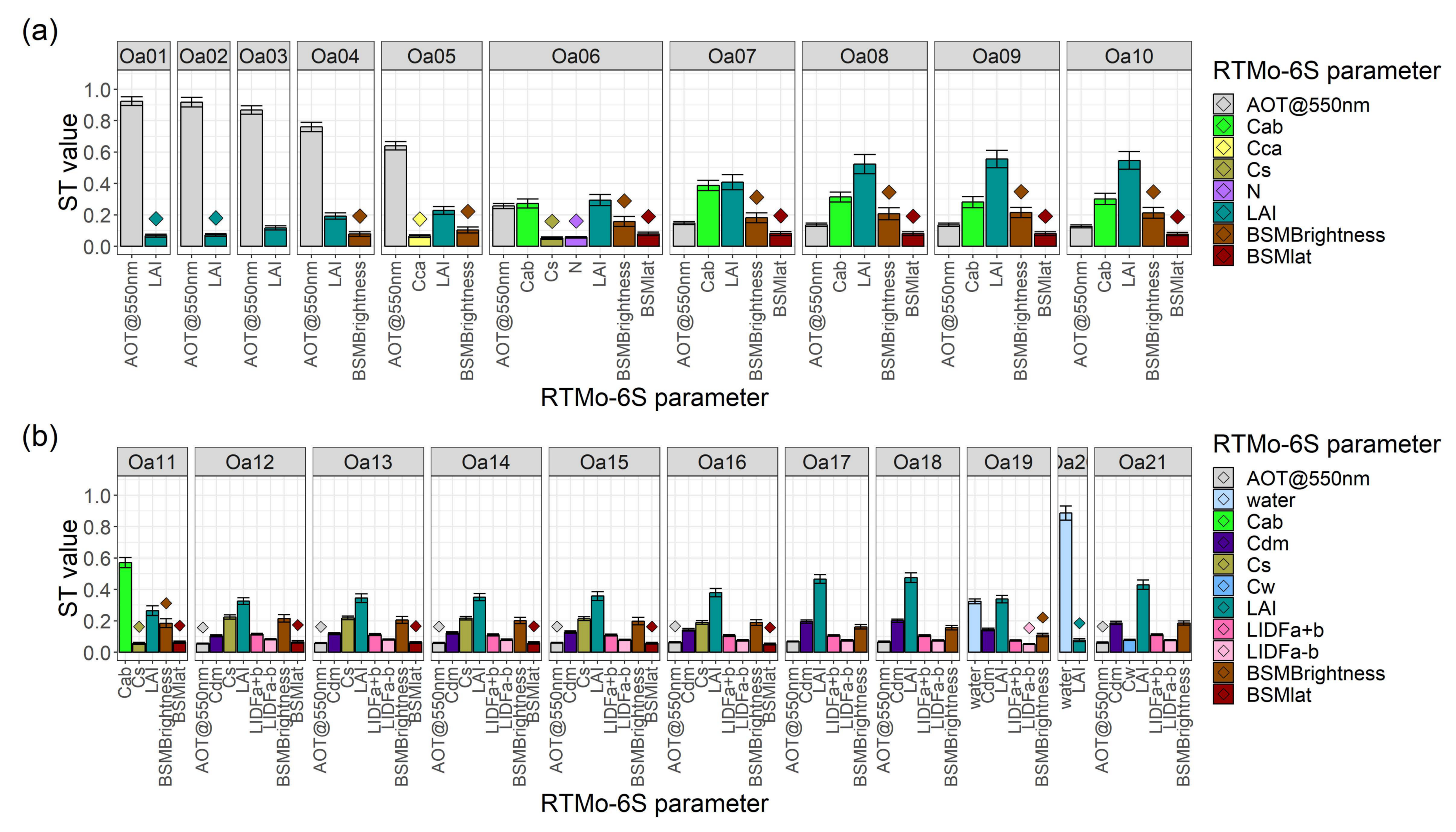




| Parameter | Definition | Unit | Min | Max | Default |
|---|---|---|---|---|---|
| Leaf (RTMo) | |||||
| Cab | chlorophyll a,b content | g cm | 0 | 100 | 40 |
| Cca | carotenoid content | g cm | 0 | 30 | 10 |
| Cant | antocyanin content | g cm | 0 | 30 | 1 |
| Cdm | dry matter content | g cm | 0 | 0.05 | 0.012 |
| Cw | water thickness | cm | 0 | 0.1 | 0.009 |
| Cs | senescent material fraction | - | 0 | 0.9 | 0 |
| N | mesophyll structure | - | 1 | 4 | 1.5 |
| Canopy (RTMo) | |||||
| LAI | leaf area index | m m | 0 | 7 | 3 |
| LIDFa | leaf inclination distribution function parameter a | - | −1 | 1 | 0.35 |
| LIDFb | leaf inclination distribution function parameter b | - | −1 | 1 | −0.15 |
| Soil (RTMo) | |||||
| BSMBrightness | BSM model parameter soil brightness | - | 0 | 0.9 | 0.5 |
| BSMlat | BSM model parameter lat | - | 20 | 40 | 25 |
| BSMlon | BSM model parameter lon | - | 40 | 60 | 45 |
| SMC | volumetric soil moisture content | % | 5 | 55 | 30 |
| Atmosphere (6S) | |||||
| AOT@550 | aerosol optical thickness at 550 nm | - | 0 | 1 | 0.01 |
| water | atmospheric columnar water pressure | g cm (kg m) | 0 | 7.5 (75) | 1 (10) |
| ozone | atmospheric columnar ozone pressure | atm-cm (kg m) | 0 | 0.7 (0.015) | 0.326 (0.007) |
| Angles (RTMo-6S) | |||||
| sza | solar zenith angle | deg | 50 | ||
| oza | observation zenith angle | deg | 22 (50) | ||
| saa | solar azimuth angle | deg | 150 | ||
| oaa | observation azimuth angle | deg | 100 (195) | ||
| Parameter | Definition | Unit | Min | Max | Default |
|---|---|---|---|---|---|
| Soil | |||||
| BSMBrightness | BSM model parameter soil brightness | - | 0 | 0.9 | 0.5 |
| BSMlat | BSM model parameter lat | - | 20 | 40 | 25 |
| BSMlon | BSM model parameter lon | - | 40 | 60 | 45 |
| SMC | volumetric soil moisture content | - | 0.1 | 0.7 | 0.25 |
| Leaf | |||||
| Cab | chlorophyll a,b content | g cm | 0 | 100 | 40 |
| Cca | carotenoid content | g cm | 0 | 30 | 10 |
| Cant | antocyanin content | g cm | 0 | 30 | 1 |
| Cdm | dry matter content | g cm | 0 | 0.05 | 0.012 |
| Cw | water thickness | cm | 0 | 0.1 | 0.009 |
| Cs | senescent material fraction | - | 0 | 0.9 | 0 |
| N | mesophyll structure | - | 1 | 4 | 1.5 |
| Canopy | |||||
| LAI | leaf area index | m m | 0.13 | 10 | 3 |
| LIDFa | leaf inclination distribution function parameter a | − | −1 | 1 | 0.35 |
| LIDFb | leaf inclination distribution function parameter b | − | −1 | 1 | −0.15 |
| Aerodynamics | |||||
| Cd | leaf drag coefficient | − | 0.001 | 1 | 0.3 |
| leafwidth | leaf width | m | 0.001 | 0.5 | 0.1 |
| rwc | within canopy layer resistance | s m | 0 | 20 | 0 |
| hc | canopy height | m | 0.01 | 50 | 2 |
| rbs | soil boundary layer resistance | s m | 5 | 30 | 10 |
| rss | soil resistance for evaporation from the pore space | s m | 100 | 5000 | 500 |
| lambdas | heat conductivity of the soil | J m K | 1 | 2 | 1.55 |
| Biochemical | |||||
| Vcmax (Vcmo) | maximum carboxylation rate at 25 C | mol m s | 0 | 250 | 60 |
| m | slope of leaf conductance-to-photosynthesis | - | 2 | 20 | 8 |
| kV | Vcmax canopy extinction coefficient | - | 0 | 0.8 | 0.64 |
| Rdparam | dark respiration parameter | - | 0.001 | 0.03 | 0.015 |
| Environment | |||||
| p | air pressure | hPa | 500 | 1030 | 970 |
| rH | relative humidity | - | 0 | 1 | 0.64 |
| u | wind speed at height z | m s | 0.5 | 10 | 2 |
| Ca | atmospheric CO concentration | ppm | 200 | 500 | 380 |
| Ta | air temperature | C | 5 | 35 | 20 |
| Rin | broadband incoming shortwave radiation (0.4–2.5 um) | W m | 0 | 1000 | 600 |
| Rli | broadband incoming longwave radiation (2.5–50 um) | W m | 200 | 500 | 300 |
| Calculated | |||||
| z | measurement height of meteorological data | m | |||
| zo | roughness length for momentum of the canopy | m | |||
| d | displacement height | m | |||
| ea | atmospheric vapour pressure | hPa | |||
| Angles | |||||
| tts | solar zenith angle | deg | 50 | ||
| tto | observations zenith angle | deg | 22 (50) | ||
| psi | relative azimuth angle | deg | 130 (135) | ||
| Metric | Instrument | B | BSMlat | BSMlon | SMC | Cab | Cca | Cant | Cdm | Cw | Cs | N | LAI | LIDFa | LIDFb |
|---|---|---|---|---|---|---|---|---|---|---|---|---|---|---|---|
| RMSE | OLCI | 0.3 | 8.8 | 7.1 | 18.1 | 10.9 | 2.8 | 0.9 | 0.006 | 0.024 | 0.1 | 0.7 | 0.9 | 0.3 | 0.4 |
| Synergy | 0.2 | 7.0 | 6.0 | 17.6 | 6.7 | 2.8 | 1.1 | 0.005 | 0.025 | 0.1 | 0.6 | 0.9 | 0.2 | 0.4 | |
| RRMSE | OLCI | 53 | 31 | 15 | 61 | 20 | 25 | 43 | 57 | 25 | 15 | 30 | 34 | 742 | 508 |
| Synergy | 45 | 24 | 12 | 59 | 12 | 25 | 54 | 48 | 25 | 11 | 27 | 34 | 533 | 532 | |
| R | OLCI | 0.33 | 0.00 | 0.09 | 0.22 | 0.83 | 0.86 | 0.73 | 0.46 | 0.83 | 0.91 | 0.33 | 0.85 | 0.64 | 0.04 |
| Synergy | 0.45 | 0.16 | 0.31 | 0.16 | 0.92 | 0.85 | 0.62 | 0.55 | 0.81 | 0.95 | 0.44 | 0.86 | 0.82 | 0.01 |
© 2019 by the authors. Licensee MDPI, Basel, Switzerland. This article is an open access article distributed under the terms and conditions of the Creative Commons Attribution (CC BY) license (http://creativecommons.org/licenses/by/4.0/).
Share and Cite
Prikaziuk, E.; van der Tol, C. Global Sensitivity Analysis of the SCOPE Model in Sentinel-3 Bands: Thermal Domain Focus. Remote Sens. 2019, 11, 2424. https://0-doi-org.brum.beds.ac.uk/10.3390/rs11202424
Prikaziuk E, van der Tol C. Global Sensitivity Analysis of the SCOPE Model in Sentinel-3 Bands: Thermal Domain Focus. Remote Sensing. 2019; 11(20):2424. https://0-doi-org.brum.beds.ac.uk/10.3390/rs11202424
Chicago/Turabian StylePrikaziuk, Egor, and Christiaan van der Tol. 2019. "Global Sensitivity Analysis of the SCOPE Model in Sentinel-3 Bands: Thermal Domain Focus" Remote Sensing 11, no. 20: 2424. https://0-doi-org.brum.beds.ac.uk/10.3390/rs11202424




